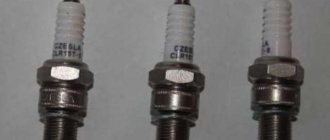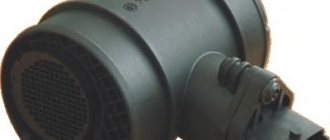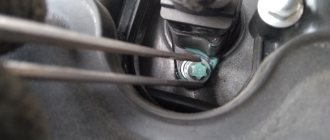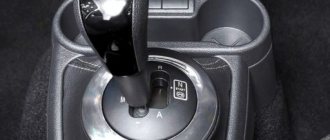The VAZ 21214 engine was developed by VAZ for off-road vehicles of its own production, Niva. The design of the internal combustion engine is developed on the basis of the 21213 engine using parts and assembly units included in the 2112 specification. In modifications, individual components are taken from the 2123 engine. The internal combustion engine differs from the 21213 in the presence of: an injector (assembled); catalyst; hydraulic compensators for timing valves; power steering; engine assembly units modified for injector. The series was launched in 1994, later including modifications, and was used in the assembly of the VAZ Niva (2121, 21213, 21214, 2131) and Nadezhda 2120 SUVs.
Initially, the unmodified engine model had centralized fuel injection from one injector (in the intake manifold) into 4 cylinders. The first modification of the 21214-10 engine received distributed injection from four individual injectors (1 per cylinder), with a Bosch MP7.0 controller and compliance with Euro 2. With the transition to Euro 3 and the installation of hydraulic compensators in the valve mechanism, it entailed further refinement of the internal combustion engine. Using certain innovations, the following subsequent modifications of the engine were produced.
VAZ 21214 engine modifications and their differences
| Motor modification | Availability of power steering | An exhaust manifold | EURO environmental class |
| 21214-41 | + | welded from stainless steel become | 3 |
| 21214-34 | _ | cast iron | |
| 21214-33 | + | ||
| 21214-32* | |||
| 21214-31 | welded from stainless steel become | 4 | |
| 21214-30 | — |
*21214-32 – has fuel pipes with quick connectors, a flywheel for the clutch of 215 mm (200 mm on other models).
The geometry of the cylinder block 21214 and 21213 is the same. There are no liners in the cylinders. Due to the use of an ejector, the configuration of the front engine cover has been changed to accommodate the installation of a crankshaft position sensor. To mount the power steering, a hole is made on the block for installing a bracket; in addition, there is a threaded hole for installing a knock sensor, as well as threaded holes with studs for mounting the ignition module bracket.
The ShPG came from 21213. Crankshaft 21213-1005015 sets the piston stroke to 80mm. The crankshaft pulley is distinguished by the presence of teeth along the outer diameter for the operation of the crankshaft position sensor. The latest internal combustion engine models are equipped with a damping pulley (21214-1005058-10). The presence of a damper made it possible to reduce the load on the crankshaft to prevent cutting of the key, and also make the operation less noisy.
Cylinder head 21214-1003011-30 (36) was modified from the head from 21213. For modification, it was necessary to introduce holes for installing a phase sensor and studs for mounting the intake receiver. To install hydraulic compensators, bosses are cast in the head and have threaded holes in them. With the introduction of hydraulic thermal gap compensators, adjusting bolts were eliminated from the head design. Oil under pressure is supplied to the hydraulic compensators through separate pipes. There are two types of heads: Russian 21214-1003015 and Canadian 21214-1003015-30. The differences between the heads are as follows: in the first, the diameter of the threads in the holes for hydraulic compensators is M18/1.5, the wells for hydraulic compensators do not have drainage holes; the second ones have M24x1.5 holes, and the wells have drainage holes (the markings are made in the casting). Interchangeability of heads, as well as hydraulic supports of old and new designs, is not possible. A new oil rail 21214-1007180-30 made of stainless steel was used, supplying oil to the hydraulic compensators. Interchangeability with ramp 21214-1007180 is maintained.
Valve levers 21214-1007116-30, in contrast to the previous 2101-1007116, have a smaller radius (11 mm) of the platform support interacting with the camshaft cam, as well as an additional groove on the side of the hydraulic compensator. Both lever options are interchangeable.
In the timing camshaft drive, instead of a double-row chain, a single-row chain 21214-1006040-03 is used on rollers and bushings. Single-row sprockets for the chain were taken from the 2123 motor. The number of teeth on the oil pump sprocket was reduced to 30 to increase the performance of the oil pump and improve the operation of the hydraulic chain tensioner and hydraulic compensators. The external difference is complemented by a solid steel tube with a diameter of 6 mm for supplying oil to the hydraulic chain tensioner. Previous engine models used a coiled-brazed tube of smaller diameter.
The camshaft 21214-1006010 is original with a modified cam profile and can be interchanged with the shaft from 21213.
The 80 amp generator is the same as the 2112, with a slight difference in the diameter of the pulley 80 mm for the drive belt 2107-1308020 (944 mm).
The exhaust manifold can be made of cast iron or stainless steel. The cast iron manifold is made by casting. The stainless steel manifold version has a welded design. A welded manifold is lighter and heats up quickly, which is good for the operation of the catalyst located in the manifold. In addition, an oxygen sensor is installed in the exhaust manifold.
The intake manifold and fuel rail (2123-1144010-11) were borrowed from the 2123 engine. The injectors of the fuel injection system are SIEMENS VAZ 20734 (yellow), injectors (0280 158 110) were installed on early engines.
Ignition module from engine 2112.
Electronic control is carried out by the BOSCH MP 7.9.7 ECU. or JANUARY 7.2 depending on the year of manufacture and modification of the internal combustion engine.
The cooling system began to be assembled using gaskets with an elastic polymer bead, which improved the tightness of the system. The water pump (pump) includes an oil seal (cuff) that is more resistant to wear and loss of properties.
Description of the motor device 21213
The basis of the VAZ 21213 engine includes:
- cast iron cylinder block (BC) 21213-1002011;
- block head 21213-100301*;
- crankshaft 21213-1005015;
- connecting rod and piston group 21213-10040*.
The main difference between the 21213 engine and its predecessors was the increased cylinder diameter - 82 mm versus 76 and 79 mm. The center-to-center distance of 95 mm remains the same, and allows the block to be bored to a diameter of 82.8 mm. The design of the water jacket has changed. The working volume has increased by 100 cm3, but the engine dimensions have remained the same.
To install the crankshaft in the BC there are 5 supports: one each on the front and rear walls, 3 more on the ebb. The crankshaft parameters provide a piston stroke of 80 mm. The crankshaft is cast from cast iron and consists of 4 connecting rods and 5 main journals. The connecting rod journals have oil channels. The necks are separated by cheeks with counterweights. In previous VAZ engines, balancing counterweights were found only in the outer and central cheeks. The axial movement of the shaft is limited by thrust half-rings.
The piston group for the 21213 engine was developed anew. Pistons 21213-1004015 are cast from aluminum and reduced to a single mass of 347 g. The piston class (A, B, C, D, E) is determined by the outer diameter in increments of 0.01 mm. The shape of the piston is conical in height and oval in cross section. The hole for the pin is 22 mm, offset by 1.2 mm from the piston axis. The finger is locked with rings. There are 3 rings installed on the piston skirt:
- upper compression barrel;
- medium oil scraper with expansion coil spring;
- lower compression scraper type.
The connecting rod 21213-1004045 is forged from steel and processed together with the cover. A steel-bronze bushing is pressed into the upper head of the connecting rod. To fasten the connecting rod, M9x1.0x56 bolts are used.
The aluminum BC head is designed for the VAZ 21213 engine and is designed for compression from 10 bar. Installing a head from other motors may cause it to break. Cast iron seats and guide bushings for 4 intake and 4 exhaust valves are pressed into the head. The valves operate from the camshaft cams. The gap between the valve stem and the cam is adjusted with a bolt.
Similar article Technical characteristics of the VAZ 21214 engine
timing belt
The camshaft 21213-1006010 is made of cast iron and rests on 5 journals. The jaws are bleached to increase wear resistance. Axial movement of the shaft is limited by a thrust flange.
The timing belt is driven by a double-row bush-roller chain. In addition to the camshaft, the chain drives the oil pump. The drive is regulated by a semi-automatic tensioner with a shoe and damper. To prevent the chain from falling off when removing the camshaft sprocket, a limiter is provided next to the crankshaft drive sprocket.
Systems
The power supply system in the Niva 21213 engine is a 21073 Solers carburetor. The carburetor unit is two-chamber, the throttle valves operate sequentially. When the first chamber is 2/3 open, the throttle of the second chamber is engaged. At idle, the economizer turns on. The carburetor device includes:
- float chamber;
- 2 dosing systems;
- crankcase gas suction system;
- heating the throttle zone of the first chamber;
- blocking the second camera;
- economizer;
- econostat;
- diaphragm accelerator pump.
The ignition system in the 21213 engine is non-contact. The system is controlled by a switch using distributor signals. In general, the system is classic, without any special features.
Cooling of the motor occurs according to a typical scheme: liquid circulates through the water jacket in the BC and the block head. The pressure is created by a centrifugal pump connected by a belt drive to the crankshaft and generator. The radiator fan impeller works on suction, so in winter the radiator has to be covered with cardboard.
Technical characteristics of the internal combustion engine VAZ 21214
| Volume, cm3 | 1690 |
| Poppy. power, l. With., | 83 |
| Max. torque, Nm | 129 |
| Arrangement of cylinders in the block | in-line |
| Cylinders, pcs. | 4 |
| Valves, pcs. | 8 |
| Max. speed, km/h | 142 |
| Acceleration to 100 km/h | 17 |
| Combined fuel consumption | 10 |
| Environmental standards | EURO-4 |
| Cylinder diameter, mm | 82 |
| Piston stroke, mm | 80 |
| Compression ratio | 9,4 |
| Supply system | distributed injection |
| Cooling | liquid |
| Valve mechanism | SOHC |
| Cylinder block material | cast iron |
| Cylinder head material | aluminum |
| Resource, km | 80,000, in fact up to 150,000 |
| Clock (number of clock cycles) | 4 |
| Cylinder operating order | 1-3-4-2 |
| Max. c/v speed, rpm | 8000 |
| Recommended fuel | unleaded gasoline AI-95 |
How to increase engine power?
The most expensive way is to use the services of specialists to carry out complete tuning. But there are other, more democratic and affordable options. For example, installing a Priora engine in a field, or rather an engine with 98 horsepower, which has a volume of 1.6 liters and 16 valves. The most obvious disadvantages of such a replacement include bent valves if the timing belt breaks. But other vehicles are not immune from this, so we can classify this drawback as minor and not rely on it when carrying out work.
Weaknesses of the VAZ 21214 engine
In addition to the weak points of the base 21213, the motor has the following weak points:
Cylinder block. This weak point appears on various models of Nivov engines, including the previously discussed 21213. Due to insufficient quality control, the assembly unit is manufactured with a high percentage of factory defects. In short, the drilling depth of the intake manifold stud holes is not maintained, causing the holes to meet the camshaft stud holes. In this way, L-shaped through channels are obtained. After installing the studs at the factory, the connections remain sealed for some time and the problem is not identified when the quality control department employees accept engine tests. After the sale of new cars with low mileage, during sharp braking, oil begins to seep through the studs onto the hot intake manifold, so much so that smoke from the oil burning in the manifold pours out from under the hood, and accordingly, there is nothing to breathe in the cabin. It would seem that there is a manufacturing defect and it should be fixed free of charge or the cars should be recalled altogether to eliminate the defect, but that was not the case. In service centers they pretended to know nothing until the very end...
The most interesting thing is that AvtoVAZ knows about this problem and, in response to questions in correspondence with car owners, advises eliminating it according to the following technical specifications:
A sketch for the technical specifications for eliminating oil leaks from under the exhaust manifold studs.
- Remove the GC cover;
- Unscrew the two studs securing the bearing housing (see sketch) and remove oil from the threaded holes;
- Thoroughly degrease the holes and stud;
- Apply sealant UG-10 or its analogues to the lower threads of the studs;
- Place the studs in place;
- Tighten the bearing housing nuts;
- Install the cylinder head cover;
- Wait at least 30 minutes for the sealant to set.
Engine tuning
Tuning a VAZ 2121 engine is an art. Since the car has the characteristics of an SUV, the engine is tuned accordingly. The air filter duct is installed as high as possible, and the motor from below is protected by a special tray, the purpose of which is not to allow water to pass through.
So, the modification of the Niva’s power unit is designed to increase cross-country ability and traction capabilities, since the vehicle is mainly designed for operation on rough terrain. So, many car enthusiasts bore the power unit in such a way as to add not only horsepower, but also traction.
As practice shows, tuning of VAZ 2121 engines and its modifications is carried out by tuning studios that are well versed in which unit needs to be modified.
Also, in the process of refinement, the ignition system and fuel injection are being modernized. For carburetor engines, an additional carburetor can be installed to increase the amount of fuel entering the combustion chamber.
For injection versions of engines, chip tuning is carried out, which can be aimed at increasing power or the balance between consumption and traction capabilities. Many car enthusiasts install additional sensors that help control the operation of the power unit.
Disadvantages of the VAZ 21214 engine
The disadvantages of the base VAZ 21213 engine are complemented by:
Frequent manufacturing defects (defects) of hydraulic supports of valve levers (hydraulic compensators). Due to the low level of technological discipline and technical control at the enterprises of manufacturers of precision pairs for hydraulic mounts, parts are produced with a high number of defects, and when assembling heads at the parent enterprise (machining tolerances are not maintained, foreign objects are present, the clamping of the plunger in the hydraulic mount housing results in non-compliance with the tightening torque when installing into the head). For this reason, if the hydraulic mounts wear out, you have to install a new head complete with hydraulic mounts.
The latest engine modifications are equipped with time-tested hydraulic valve lever mounts from INA. From them we can say for sure that the risk of deformation of the housing during tightening is reduced to zero. The photo below shows a new type of hydraulic support (with M 24×1.5 thread) in detail (body, plunger) and in assembly.
Low service life before major overhaul. Saving on the quality of the materials used, along with the unreliability of components, parts and assembly units, negatively affects the reliability of the motor and its service life.
Conclusion. The quality of 21214, like other classic VAZ engines, has not advanced much since Soviet times. It is clear that the ejector with all the sensors, injectors and controller makes the engine better, but if only it could run longer and without breakdowns... The engine has a small safety margin, which cannot be ignored during operation. In order for the engine to run more than the 80,000 km service life established by the manufacturer, it is necessary to change oil, filters and other consumables more often, and to dive under the hood every now and then for routine repairs. The repair sizes of the groups are the same as those of 21213, so major repairs are easy, but not cheap. In general, if you want to buy a high-performance Niva car with this internal combustion engine, then be prepared for frequent problems with the engine, especially if the car is used.
PS Dear car owners! What weak points and shortcomings did you encounter with this engine?
The most common engine failures
ICE 21213 has typical problems of VAZ engines:
- increased oil consumption due to carbon deposits on valves and cylinders;
- the appearance of vibrations at a speed of 90 km/h. The cause is a damaged head gasket or an unadjusted carburetor;
- when the timing chain is pulled, the valve bends;
- Excessive noise due to a broken timing chain tensioner or timing chain tensioner shoe, pump bearing creaking, or unadjusted thermal clearances;
- Overheating of the unit is caused by a faulty thermostat, a clogged radiator, or prolonged operation at high speeds. Due to the design features of the BC, the thickness of the coolant layer does not provide sufficient cooling, so it is necessary to operate the unit moderately. Increased engine temperature leads to cracking of the cylinder head.
Similar article Engine for Niva from a foreign car without modifications
The disadvantages of the 21213 engine include repair features. If the wear of the cylinders exceeds 0.15 mm, then boring is permissible only for the repair dimensions of the pistons, increased by 0.4 and 0.8 mm from the nominal value. Exhausting the limit threatens to completely replace the pistons and cylinders.
Regrinding of the crankshaft journals is possible with a diameter reduction of 0.25; 0.5; 0.75 and 1 mm. The limitation is due to the repair dimensions of the liners. If the axial clearance of the crankshaft increases by more than 0.35 mm, the part must be replaced.
Advantages of the Priora engine
Based on all the characteristics and descriptions of the engine, we can say that it will be a reliable and efficient component of the vehicle, which will improve and increase its service life. It is worth noting that domestic manufacturers have been using the most modern techniques and developments for a long time, which allows them to create high-quality car components. That is why drivers have been making decisions to replace engines in their fields for a long time. Such a replacement increases the performance of the vehicle, and the costs relative to the purchase of a new car are not large.











